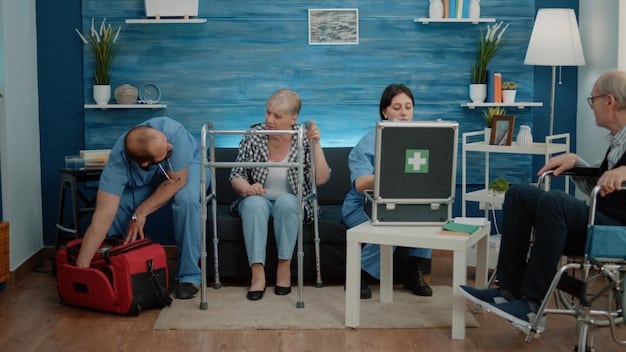Respite Care Grants: Up to $3,000 for Care in 2025

Respite care grants offer temporary relief for caregivers in the US, providing financial assistance to cover the costs of short-term care for their loved ones, potentially reaching up to $3,000 in 2025 through various federal and state programs.
Caring for a loved one can be incredibly rewarding, but it’s also demanding. Respite care grants can provide much-needed support, offering financial assistance to cover short-term care. Let’s explore how you can access up to $3,000 in 2025 to help ease the burden.
Understanding Respite Care and Its Importance
Respite care provides temporary relief to primary caregivers, allowing them to take a break from their duties. This break can range from a few hours to several days or even weeks, depending on the needs of the caregiver and the availability of resources.
It is important for caregivers’ mental and physical health, preventing burnout. It ensures that caregivers can continue providing quality care for their loved ones in the long run.
Why is Respite Care Essential?
The demands of caregiving can be overwhelming, leading to stress, exhaustion, and even health problems for the caregiver. Respite care offers a chance to recharge and attend to personal needs.
- Improved Caregiver Well-being: Respite care reduces stress and burnout, improving the caregiver’s overall quality of life.
- Enhanced Care Recipient Well-being: A refreshed caregiver is better equipped to provide attentive and compassionate care.
- Strengthened Family Bonds: Respite care can prevent caregiver resentment and maintain positive relationships within the family.
- Continuity of Care: By preventing caregiver burnout, respite care helps ensure consistent and reliable support for the care recipient.
Respite care is not a luxury—it is a necessity for sustainable caregiving. It recognizes that caregivers need support to continue providing the best possible care for their loved ones.
Exploring Federal Respite Care Programs
Several federal programs offer financial assistance for respite care, providing crucial support to caregivers across the United States. These programs are designed to help families access the resources they need to care for their loved ones effectively.
Understanding these programs can help make the process easier to navigate and obtain the help you need. This assistance comes in different forms, so be sure to evaluate which programs fit your needs accordingly.

The National Family Caregiver Support Program (NFCSP)
The NFCSP, administered by the Administration for Community Living (ACL), provides grants to states to fund a range of caregiver support services, including respite care. Each state designs its own program, so the services and eligibility requirements may vary.
To see if this program could be right for you, contact your local Area Agency on Aging (AAA) who can provide information about available services and how to apply.
Veterans Affairs (VA) Respite Care
The VA offers respite care services to eligible veterans, allowing their caregivers to take a break. These services can be provided in the veteran’s home, in an adult day health center, or in a VA medical center.
- Eligibility Criteria: Veterans must be enrolled in the VA health care system and meet certain clinical criteria to qualify for respite care.
- Types of Respite Care: The VA offers in-home respite care, adult day health care, and short-term stays in VA medical centers or community living centers.
- How to Apply: Contact your local VA medical center or a VA social worker to learn more about eligibility requirements and the application process.
The VA’s respite care program provides veterans and their caregivers with much-needed support, ensuring that both can maintain their well-being and quality of life.
State-Specific Respite Care Grants
In addition to federal programs, many states offer their own respite care grants to support caregivers. These grants are often tailored to meet the specific needs of residents within the state.
These are not all the programs that can help you, but they are a great way to start navigating some good options to investigate.

Examples of State Respite Programs
Several states have implemented innovative respite care programs. Let’s look at a couple of them to gain a better understanding of what is available.
It’s important to understand what is expected of an approval, so spend the time to ensure you fully understand the guidelines.
Navigating State Programs
Each state has its own eligibility requirements, application processes, and funding levels for respite care grants. Research is important for you to ensure you are able to qualify.
- Contact Your Local Aging and Disability Resource Center (ADRC): ADRCs can provide information about state-specific respite care programs and help you navigate the application process.
- Check the State Department of Health Website: Many state health departments have websites with detailed information about available caregiver support programs.
- Connect with Local Caregiver Organizations: Local caregiver organizations often have up-to-date information about state-specific grants and resources.
- Read online forums: Check if your local groups online can provide any information or insights into the programs available to you.
With the right information and resources, you can navigate the landscape of state-specific respite care grants and access the support you need. These often have eligibility considerations which will vary state to state.
Eligibility Requirements for Respite Care Grants
Understanding the eligibility requirements for respite care grants is crucial for determining whether you qualify for assistance. These requirements often vary depending on the specific program and funding source.
If you meet these program’s requirements, it could be extremely beneficial for you and your loved one. Take the time to find out if you qualify.
Common Eligibility Criteria
Many respite care grants have similar eligibility requirements. Here are some of the more common things to consider:
- Care Recipient’s Age and Condition: Grants may target specific age groups or individuals with particular disabilities or health conditions.
- Caregiver’s Relationship to the Care Recipient: Most programs require the caregiver to be a family member or legal guardian of the care recipient.
- Income and Financial Need: Some grants consider the caregiver’s or care recipient’s income and assets to determine eligibility.
If you and your loved one meet the criteria of the program selected, you could be on your way to receiving the assistance needed.
Documentation and Application Process
The application process for respite care grants typically involves submitting documentation to verify eligibility. Providing all the details will help expedite the decision.
While it can seem daunting and intrusive, it is usually simply for the program to gather the details needed to ensure they are placing the funds in the right spots.
Maximizing Your Chances of Approval
Applying for respite care grants can be competitive, so it’s important to present a strong application. Here are great ways to ensure you have the best chance of approval.
With so many potential applications coming in for the programs available, you will want to find ways to rise above the rest. Let’s explore ways to help with that.
Tips for a Strong Application
Submitting a complete and compelling application can significantly increase your chances of receiving a grant.
After Approval: Managing Your Grant
Once your application is approved, it’s important to manage your grant effectively to ensure you receive the maximum benefit.
- Understand the Grant Terms and Conditions: Be clear on how the funds can be used and any reporting requirements.
- Track Your Expenses: Keep detailed records of all respite care expenses to ensure you stay within the grant limits.
- Communicate with the Grant Provider: Maintain open communication with the grant provider to address any questions or concerns.
- Seek Help and Support: Reach out to local caregiver organizations or support groups for guidance and assistance with managing your grant.
Managing your grant effectively will help you make the most of the available resources and continue providing quality care for your loved one.
Other Resources and Support for Caregivers
Besides respite care grants, numerous other resources and support systems are available for caregivers. These resources can provide emotional, practical, and financial assistance to help you navigate the challenges of caregiving.
These other resources can help lift the caregiver up as well. Ensure you’re aware of what’s available so you can explore all benefits.
Non-Profit Organizations
Several non-profit organizations offer caregiver support services, including counseling, support groups, educational programs, and financial assistance.
Online Communities and Support Groups
Online communities and support groups provide a platform for caregivers to connect, share experiences, and offer mutual support.
| Key Point | Brief Description |
|---|---|
| 👍 Understanding Respite Care | Temporary relief for caregivers, preventing burnout and ensuring quality care. |
| 💰 Federal Programs | NFCSP and VA respite care offer financial aid and services for eligible caregivers. |
| 📍 State-Specific Grants | Many states provide their own grants, tailored to meet local residents’ needs. |
| 🤝 Additional Resources | Non-profits and online groups offer comprehensive support for caregivers. |
Frequently Asked Questions
▼
Respite care offers temporary relief to caregivers, reducing stress and burnout, which in turn helps ensure ongoing quality care for the caregiver’s loved one. It’s a crucial support system for those in caregiving roles.
▼
Contact your local Area Agency on Aging (AAA) or Aging and Disability Resource Center (ADRC) for information on state-specific respite care programs and resources available to caregivers in your area.
▼
Eligibility commonly hinges on the care recipient’s age, health status, caregiver kinship, and financial status. Review program guidelines to confirm details for your specific needs.
▼
Expect to provide proof of income, medical records, and documentation confirming your relationship to the care recipient. Specific requirements may differ, so verify them with the grant provider.
▼
Caregivers can also tap into resources like non-profit organizations, online support communities, and caregiver training programs that offer assistance and tools to aid in their caregiving journey.
Conclusion
Accessing respite care grants can significantly improve the lives of caregivers, offering them critical support and financial assistance. By understanding the available programs, meeting eligibility requirements, and submitting strong applications, caregivers can access the resources they need to continue providing quality care while also taking care of their own well-being.





